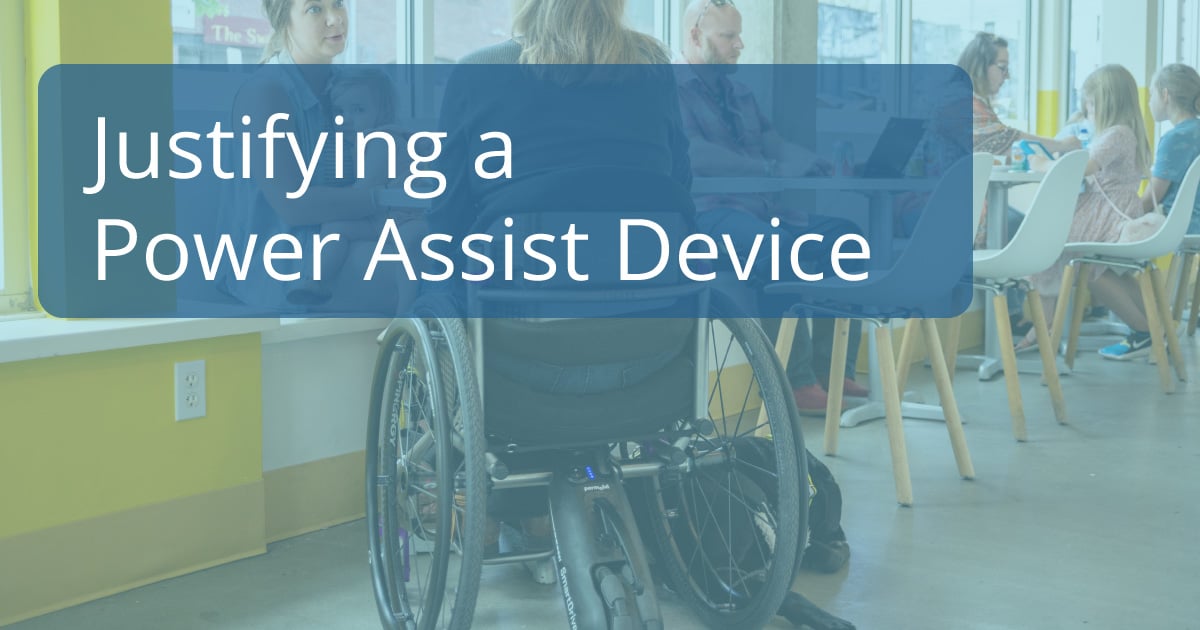For more information about power assist devices check out our 4-part series here: Part 1, Part 2, Part 3, and Part 4. Learn more about SmartDrive, Permobil's power assist device.
Anytime there is a need for complex rehab technology, it’s important to understand the criteria for reimbursement and how to justify it appropriately. We looked recently at the coverage criteria for power assist devices and this week we will look in more detail at the justification piece. This is important because once you’ve identified that a client meets the criteria for the device, you need to know how to document to get it covered.
As a quick review, SmartDrive is a compact, lightweight, rear mounted power assist device that provides power to a manual wheelchair. It’s an option that can allow manual wheelchair users who are no longer functional with propulsion to remain in their manual wheelchairs rather than moving into a full-blown power wheelchair. When considering the documentation required to justify a SmartDrive you want to paint a word picture for the reviewer that will clearly show the client’s physical limitations, functional limitations, and how SmartDrive specifically can address these and improve the client’s status. Below are some sample phrases that can be used as examples in describing the different areas. Remember these are meant to be examples and all documentation should be individualized for each client.
Need help beyond documentation? Let's connect you with our Funding Team!
Phrases related to the client’s physical presentation:
- Client presents with limited strength/weakness of the upper extremities
- Client presents with pain in upper extremities
- Client presents with limitations to range of motion of the upper extremity joints
- Client presents with decreased endurance/fatigue
- Client presents with fluctuations in muscle tone/spasticity
- Client presents with risk of skin and tissue breakdown or history of skin/tissue breakdown (might be a result of shear/friction related to strained propulsion or poor positioning during propulsion)
- Client presents with high risk of upper extremity overuse injury
- Client has a history of repetitive strain injury (rotator cuff, carpal tunnel syndrome)
- Client has postural deformities/postural instability, and these are worsened through strain of propulsion
Phrases related to the client’s functional status:
- Client is unable to self-propel a manual wheelchair for a full day and perform Activities of Daily Living tasks
- Client has difficulties or is unable to cross a street in a safe time
- Client is unable to transport items within home and outside of home and propel at the same time
- Client is unable to manage inclines, uneven terrain, thresholds within the home or changes in flooring
Phrases that answer the question “Why SmartDrive?”
- Lightweight, Transportable: The SmartDrive is 12.5 pounds and can be lifted easily into a vehicle or on and off the wheelchair by client and/or caregiver.
- Removable from wheelchair: SmartDrive is easily removed or installed onto the camber tube (or the quick release attachment on a folding chair).
- Full day battery life: The SmartDrive will allow the client to complete daily activities without the worry of the battery running low.
- Programmable and modifiable: The Pushtracker E2 device and app allow the clinician and client to program speed and acceleration rate as well as on/off for safety and independence. The settings can be changed easily on either the Pushtracker E2 device and/or the app.
- Provides power to manual wheelchair: Using the SmartDrive reduces upper extremity propulsion strokes and increases coast times, therefore lessening upper body movement and strain and providing energy conservation for the client.
- The SmartDrive enhances safety during use: For example, the client now has speed to cross at streetlights and power to manage inclines and uneven terrain.
- Use of the SmartDrive allows for enhanced function while moving in the wheelchair: The client can hold object in one hand while still controlling wheelchair with other hand (for temporary transport of items). The client can carry items more safely as client is in a stable position while moving.
- SmartDrive can be used by a caregiver as appropriate: If a client depends on a caregiver for propulsion, switch control can be used by the caregiver to engage SmartDrive when pushing up hills or over uneven terrain or even over household thresholds and carpet.
For more information on justifying SmartDrive, contact us_funding@permobil.com.
 Stacey Mullis, OTR/ATP
Stacey Mullis, OTR/ATP
Director of Clinical Marketing
Stacey serves as Director of Clinical Marketing for Permobil. A practicing OTR for over 20 years, she has experience in school-based pediatrics, inpatient rehabilitation, long term care, and home health. With her interest in wheelchair seating and positioning, Stacey engaged the challenges of providing appropriate seating in various clinical settings. She now uses this experience to develop programs and resources to educate clinicians on the principles of seating and wheeled mobility. She is passionate about equipping clinicians and through her previous role as Director of Clinical Education with Comfort Company and now with Permobil she has taught nationally and internationally to increase therapist capacity in this specialty area. Mullis graduated from Western University in London, Ontario, Canada with a BA Linguistics and BSc Occupational Therapy. She is a member of the NCOTA, CTF Executive Board, NRRTs, RESNA, and AOTA.

